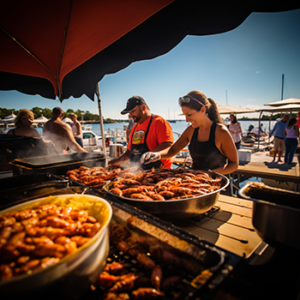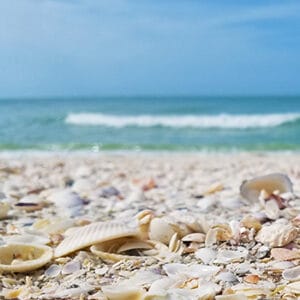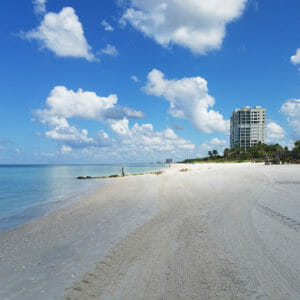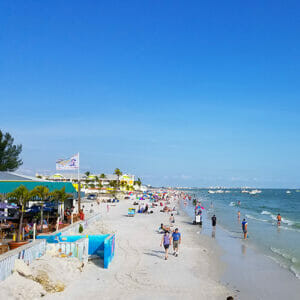
Sanibel Island Best Beach for Shelling
Sanibel Island best beach for shelling ranks among some of the most beautiful beaches in all of Florida. This island location in the sweet spot of the Gulf of Mexico where there is a constant flow of unobstructed currents washing a dazzling array of shells up onto the shoreline with each gentle wave.
In this blog we’ll highlight this best shelling beach but also another four beaches that are also known for amazing shelling opportunities.
Sanibel Island is known for its “Sanibel Stoop,” a term coined by locals and visitors alike to describe the posture of beachgoers as they comb the shoreline for shells.
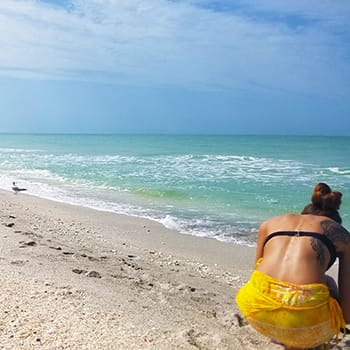
No products found.
Best Time for Shelling on Sanibel Island
The ideal time to visit Sanibel Island for shelling is during the winter months, from December to April.
This is when the island experiences its dry season, with lower humidity and cooler temperatures.
The calm waters and reduced wave action during this time make it easier to spot and collect shells.
Tides and weather patterns also play a significant role in shelling conditions on Sanibel Island.
Low tide is the best time to go shelling, as it exposes more of the beach and allows access to areas that are usually underwater. It is important to check the tide charts before planning a shelling trip to ensure optimal conditions.
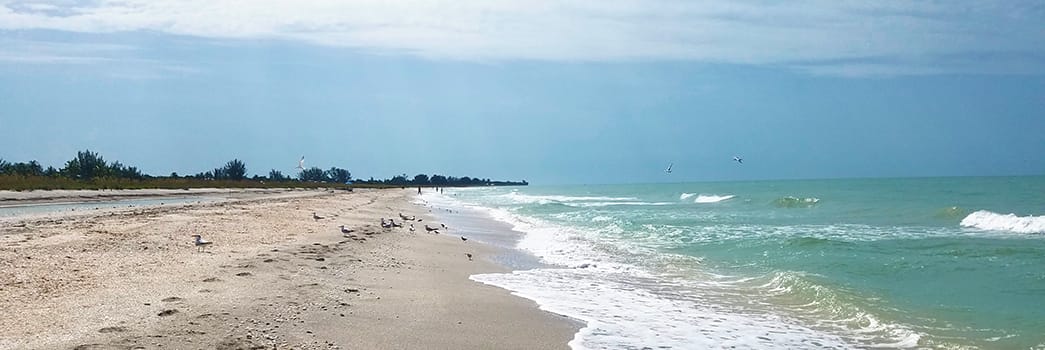
Top 5 Shelling Beaches on Sanibel Island
Bowman's Beach - #1 Sanibel Island Best Beach for Shelling
Bowman’s Beach is located on the western gulf end of Sanibel Island, and known for its wide stretch of sand and excellent shelling opportunities.
Because of its unobstructed location and seven miles of shoreline, shells naturally wash up each day in abundance. The smaller shells cover the beach shoreline, with more rolling in with each tide. The larger shells can be found in the water.
HOWEVER… ASSUME THE LARGER SHELLS IN THE WATER HAVE CREATURES STILL LIVING IN THEM… SO BE VERY CAREFUL AND MAKE SURE THEY ARE EMPTY, ABANDONED SHELLS!
This beach, Sanibel Island Best Beach for Shelling, is less crowded than some of the other popular spots on the island, making it a peaceful and serene place to search for shells.
There are no condos or hotels nearby, so it feels a bit more remote than other beaches. There are miles of shoreline for the Gulf of Mexico shells to wash up onto.
And there’s a massive amount of protected habitat making this an incredible sanctuary for tons of wildlife.
HOWEVER… some shelling enthusiasts prefer Blind Pass Beach to Bowman’s because Bowman’s is larger with more parking and easier to get to, which means more beachgoers in general especially by mid-day.

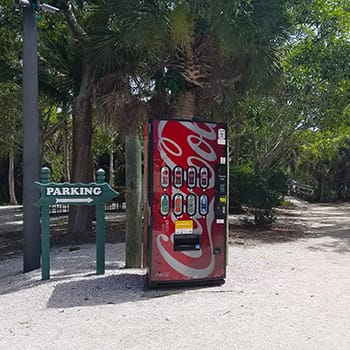
Tips for visiting Bowman’s Beach:
- Go early in the morning and at low tide to find the best shells AND to get there before any crowds!
- Wear/bring shoes and be prepared to walk because this beach is very shelly, plus you’ll be walking about 1/4 mile from your car to the beach (it’s a great walk!).
- When you’re walking along the boardwalk on your way to the beach, stop and look for manatees in this backchannel!
There are clean restrooms, showers, a soda machine, picnic area, and if you’re lucky, in addition to finding some fantastic shells you may also spot manatee, dolphin, a gopher turtle, sea turtle nests and lots of birds!
Be patient and watch for manatee, dolphin… they ARE in the Gulf of Mexico and love swimming near the shoreline and sightings are fairly common! Also look for birds, an occasional sea turtle and sting ray are also possible.
If you’re interested in birding, see our blog Birding in the Florida Keys which highlights many of the same birds you’ll find on Sanibel Island as well as the best apps to help you identify them by either sound or sight.
Here’s the official website for Bowman’s Beach on Sanibel Island.

As an Amazon Associate I earn from qualifying purchases at no additional cost to you.
Lighthouse Beach - #2 Favorite Beach for most shelling!
Lighthouse Beach is located near the historic Sanibel Island Lighthouse which is at the east end of the island (other side from Bowman’s Beach).
This always seems to be the second favorite Sanibel Island best shelling beach of visitors and shelling enthusiasts, though it’s often a tie with Blind Pass Beach for second place.
After entering onto Sanibel Island over the causeway, you’ll want to turn left (east) towards the lighthouse. Most everything else of interest is west, which lends itself to slightly less crowds.
The beach benefits from unobstructed waves of the Gulf of Mexico which wash up a constant supply of beautiful shells. For many people, this beach (and NOT Bowman’s Beach) is their Sanibel Island best beach for shelling!
This beach is known for its variety of shells, including conch shells, whelks, and cockle shells.
Tips for visiting Lighthouse Beach:
- Parking lot has limited spots so go early in the morning.
- Best selection of shells is early morning low tide.
- This beach was hit hard by the hurricane so check if amenities are open to public before you go.
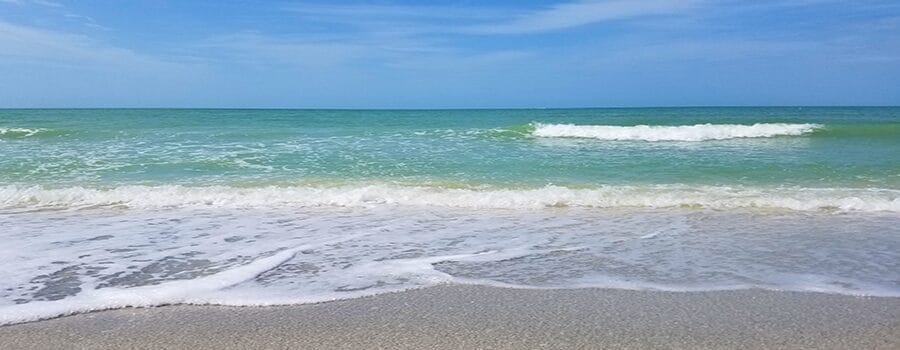
Blind Pass Beach - Also a favorite Sanibel Beach for Shelling!
Blind Pass Beach is situated at the northern tip of Sanibel Island, where it meets Captiva Island. This beach is known for its strong currents, which naturally bring in the larger shells.
Shelling enthusiasts love this beach especially during low tide.
This is not the best beach for families as this isn’t a swimming beach (currents too strong and undertows can be dangerous).
Also, there aren’t the same amenities like clean restrooms with showers and vending machine like at Bowman’s Beach, plus parking spaces are very limited. This, however, makes this beach more attractive for certain shelling enthusiasts.
This beach also has access to a bridge you can successfully fish from, as many have caught snook and snapper and even sharks! Beach fishing is also popular here.
Gulfside City Park Beach
Gulfside City Park Beach, also known as Algiers Beach, is a popular spot for both locals and tourists. The beach is easily accessible but there are very limited parking spots (46 to be exact!).
It’s got some condos to one side and it’s centrally located on the island, which makes this beach a little more popular than others.
Swimming is great at this beach as there are generally no strong currents (like at Blind Pass Beach).
There are restrooms here as well as outdoor showers and drinking fountains, picnic tables and grills.
Shellers can expect to find a wide variety of shells, including scallops, olives, and augers.
Tarpon Bay Beach
Tarpon Bay Beach is a smaller beach located in the middle of Sanibel Island, making it a convenient choice for both locals and tourists.
Parking is about a 5 minute walk along a boardwalk and in between some condo buildings. to the beach itself There are a couple of large RV parking spots here as well.
You’ll pass some small swampy areas which some have seen small alligators in. This beach has a more “commercial” feel than others that feel more “remote”, due to the many condo buildings.
Shelling is still very strong here, and best at low tide and early morning before your competition for finding the best shells arrives.

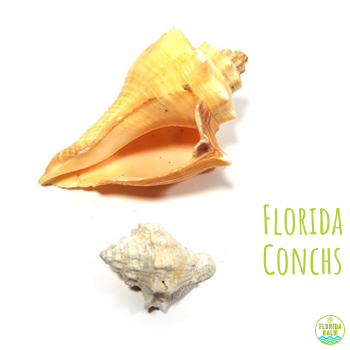
Types of Shells You'll Find on Sanibel Island
Due to it’s unique location and favorable conditions for shell accumulation, Sanibel Island’s beaches offer an unparalleled range of seashell types.
Some of the most sought after shells include lightning whelks, alphabet cones, tulip shells and fighting conchs.
- Lighting (Florida) Whelk: Long spire shell with a heavier weight, can be found quite large. Come in a variety of colors including oranges, browns and sometimes purple-ish! These shells start as homes for snails, then later become homes for hermit crabs.
- Conch: Knobbed conch and Fighting conch are commonly found on Sanibel’s beaches, and these shells can be quite large. It’s good practice to leave any you find in the water as they are current home to a creature inside OR they are needed by hermit crabs.
- Coquina: These small clam shells are some of the most abundant shells on Sanibel Island. They often come in clusters and can be quite colorful, smooth and shiny.
- Turkey Wing Shells: These triangular-shaped shells have a pointed beak and a flared lip. They come in a variety of colors, including browns, oranges, and creams.
- Venus Shells: Florida Cross-barred Venus has a ridged or “cross-barred” surface with a variety of colors including cream, yellow, orange, and purple. The interior of the shell is also quite colorful, with intricate patterns of purple, pink, and orange.
- Jingle Shells: One of the most abundant types of shells on Sanibel Island! These beautiful shells often appear iridescent and translucent, and come in a variety of colors.
In addition to these common shells, Sanibel’s beaches are also known for their rare finds. The junonia shell is one of the most prized finds among shell collectors, and can be spotted by its distinct brown spots and rarity.
Other rare shells that can be found on the island include the lion’s paw, wentletrap and golden olive.
Tips for Finding the Best Shells on Sanibel's Beaches
Finding the best shells on Sanibel Island requires a combination of patience, persistence, and a keen eye. Here are some pro shelling tips:
1. Low tide and early morning is best: Plan for shelling at low tide, which you can plan by using tide charts. Check this simple chart for times of low and high tides: City of Sanibel Tides Chart. Early morning is also best, get there before others who are looking for the best shells!
2. Scan the shoreline slowly in a pattern: Take your time as you walk along the beach, scanning the shoreline for shells in a small pattern. Shells can be easily missed, so a methodical intentional approach can work well.
3. Look for shell piles: Shells can often accumulate in piles, especially near sandbars and small channels made by strong currents. These shell piles can be a treasure trove of special shells, and lots of fun to search through!
4. Bring a shelling bag or bucket: Be prepared by bringing a mesh bag or buck with holes that will allow sand and water to drain out, keeping your shells safe.
5. Only take empty shells: When collecting, make sure shells are all empty. Remember, all shells were inhabited by live creatures at one point, and they might still be inside. It’s also important to be mindful of any regulations or restrictions in place to protect the island’s natural resources.
History of Shelling on Sanibel Island
Shelling on Sanibel Island goes back centuries. The Calusa Native Americans were the first known shell collectors on the island, using shells for tools, jewelry, and ceremonial purposes.
The Calusa believed that shells held spiritual significance and were a symbol of wealth and power.
In the late 19th century, Sanibel Island became a popular destination for winter tourists, who were drawn to the island’s natural beauty and abundance of shells.
Over time, shelling on Sanibel Island has evolved from a leisurely pastime to a beloved hobby and even a competitive sport. The island hosts an annual Sanibel Shell Show, where collectors from around the world showcase their prized shells and compete for awards.
89th Annual Sanibel Shell Show, March 2025!
A significant part of the Sanibel Island shelling culture culminates each year in March at the annual Sanibel Shell Show. 2025 will mark the 89th show put on by the Sanibel-Captiva Shell Club.
It’s a big deal and lots of fun with shell shows and exhibits, jewelry vendors, food trucks and lots of fun.
Check out places to stay on Sanibel Island and compare prices, ratings and when you find a good deal, book your stay! (Expedia affiliate link)
How to Clean the Shells You've Collected
Once you’ve collected your shells from Sanibel Island, it’s important to clean and preserve them properly to ensure their longevity. Here are some best practices for cleaning and preserving your shells:
1. Rinse with freshwater: Start by rinsing your shells with freshwater to remove any sand or debris. Use a gentle stream of water or soak them in a bucket for a few minutes.
2. Soak in bleach solution: To remove any organic matter or discoloration, soak your shells in a solution of one part bleach to three parts water. Be sure to wear gloves and work in a well-ventilated area when handling bleach. Soak the shells for 24-48 hours, checking periodically to see if they have lightened in color.
3. Rinse again: After soaking in the bleach solution, rinse your shells thoroughly with freshwater to remove any remaining bleach residue.
4. Air dry: Allow your shells to air dry completely before handling or storing them. Placing them in direct sunlight can help speed up the drying process.
5. Apply mineral oil: To enhance the natural beauty of your shells and prevent them from becoming brittle, you can apply a thin layer of mineral oil. Use a soft cloth or brush to gently rub the oil onto the shells, taking care not to apply too much.
When it comes to storing and displaying your shells, there are lots of options. You can arrange them in a shadow box or display case, use them as decorative accents in a glass jar or vase, or incorporate them into crafts and DIY projects.
While Shelling, What Else You Can Enjoy...
While shelling is undoubtedly the main attraction on Sanibel Island, there are plenty of other activities and attractions to enjoy during your visit. Here are some suggestions:
1. Wildlife spotting: Sanibel Island is home to an abundance of wildlife, including dolphins, manatees, and a variety of bird species. Take a kayak or boat tour to explore the island’s mangrove forests and estuaries, where you can spot these incredible creatures in their natural habitat.
2. Biking: Sanibel Island is known for its extensive network of bike paths, making it a great destination for cycling enthusiasts. Rent a bike and explore the island’s scenic trails, taking in the beautiful views and lush vegetation along the way.
3. Visit the J.N. “Ding” Darling National Wildlife Refuge: This 6,400-acre wildlife refuge is a haven for nature lovers. Take a drive or bike ride along the refuge’s scenic loop road, where you can spot a wide variety of birds, alligators, and other wildlife.
4. Explore the local art scene: Sanibel Island is home to numerous art galleries, studios and gift shops showcasing the work of local artists. Take some time to explore these galleries and shops and discover unique pieces inspired by the island’s natural beauty.

FAQs
What is Sanibel Island?
Sanibel Island is a barrier island located on the Gulf of Mexico in Southwest Florida.
Why is Sanibel Island known for shelling?
Sanibel Island is known for shelling because of its unique east-west orientation, which allows for a large amount of shells to wash up on its shores.
What types of shells can be found on Sanibel Island?
Sanibel Island is home to over 250 species of shells, including conch shells, sand dollars, and lightning whelks.
When is the best time to go shelling on Sanibel Island?
The best time to go shelling on Sanibel Island is during low tide, which occurs twice a day. The best months for shelling are typically September through April.
Are there any rules or regulations for shelling on Sanibel Island?
Yes, there are rules and regulations for shelling on Sanibel Island. It is illegal to take live shells, and there are limits on the amount of certain types of shells that can be collected.
What other activities are available on Sanibel Island?
In addition to shelling, Sanibel Island offers a variety of activities such as biking, kayaking, and fishing. The island is also home to several nature preserves and wildlife refuges.
We think you may also like…











